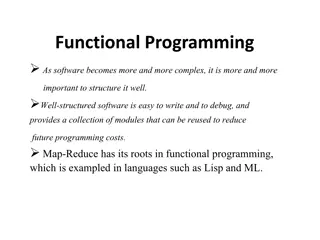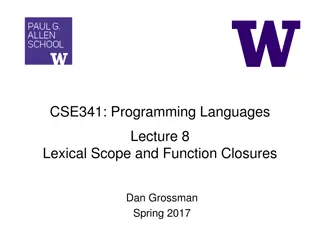Understanding Functions in Programming
Functions in programming are sub-programs that act on data and often return a value, making programs more readable and manageable. This content explains the concept of functions, how to define and use them, passing arguments, and invoking functions. Examples and visuals are provided to enhance understanding.
Download Presentation

Please find below an Image/Link to download the presentation.
The content on the website is provided AS IS for your information and personal use only. It may not be sold, licensed, or shared on other websites without obtaining consent from the author. Download presentation by click this link. If you encounter any issues during the download, it is possible that the publisher has removed the file from their server.
E N D
Presentation Transcript
Functions Functions
A function is a sub program that acts on data and often returns a value. A function make a program more readable and understandable to a programmer thereby making program management much easier Introduction
2x power of 2 F(x)=2x power of 2 The notation f(x)=2x power of 2 can be termed as a function. F,x is its argument value given to it,and 2x power of 2 is its functionality. You can create functions in a program that: Can have arguments(values given to it),if needed. Can perform certain functionality. can return a result Understanding functions
For example: Def calcSomething(x): r=2*x**2 return r
Def means a function definition is starting. Function name is calcSomething The variable/identifiers inside the parentheses are the arguments or parameters(values given to function),here x is the parameter to function calcSomething
def calcSomething(x): r=2*x**2 return r a=int(input("Enter a number:")) print(calSomething(a)) What is the output??
Calling /Invoking/Using a function: <Function-name>(<value to be passed to parameter>) Calc something(5) # value 5 is being sent as parameter. a=7 Calcsomething(a) # This time variable a is being sent as argument.
(i) Passing literal as argument in function call Cube(4) # it would pass vale as 4 to argument x (II)Passing variable as argument in function call num=10 Cube(num) # It would pass value as variable num to argument x
(III) Taking input and passing the input as argument in function call Mynum=int(input( Enter a number: )) Cube(mynum) #It would pass value as variable mynum to argument x. (iv) using function call inside another statement Print(cube(3)) #Cube(3) will first get the computed result #which will be then printed.
Using function call inside expression doubleOfCube=2*cube(6) # function call s result will be multiplied with 2
1.Built-in functions 2.Functions defined in modules 3.User defined functions 1.Built in funcTions: These are predefined functions and are always available for use.You have used some of them-len(),type(),int(),input(). 2.Functions defined in modules: These functions are pre-defined in particular modules and can only be used when the corresponding module is imported.For eg sin Python Function Types
User defined functions: These are defined by the programmer.As programmers you can create your own functions.
def sumof3Multiples1(n): s=n*1+n*2+n*3 print(s) sumof3Multiples1(1) Contd...
Output: 6
def areaOfSquare(a): return a*a areaOfSquare(5) Output:
def areaOfSquare(a): print(a*a) areaOfSquare(5) Output: 25
Top level statement: def calc(): Print( Hi there ) Print( At the top-most level right now ) Print( inside ,_name_) Structure of a python program
Flow of Execution: It refers to the order in which statements are executed during a program run. A function body is also a block.In python, a block is executed in an execution frame.
def calcSum(x,y): s=x+y print("sum of two given number is",s) return num1=float(input("Enter first number:")) num2=float(input("Enter second number:")) sum=calcSum(num1,num2) Output: Enter first number:34 Enter second number:56 sum of two given number is 90.0
def calcSum(x,y): s=x+y return print("sum of two given number is",s) num1=float(input("Enter first number:")) num2=float(input("Enter second number:")) sum=calcSum(num1,num2) Output: Traceback (most recent call last): File "C:/Python37-32/hjjj.py", line 4, in <module> print("sum of two given number is",s) NameError: name 's' is not defined >>>
def calcSum(x,y): s=x+y return num1=float(input("Enter first number:")) num2=float(input("Enter second number:")) sum=calcSum(num1,num2) print("sum of two given number is",sum) Output: Enter first number:34 Enter second number:56 sum of two given number is None >>>
def calcSum(x,y): s=x+y return s num1=float(input("Enter first number:")) num2=float(input("Enter second number:")) sum=calcSum(num1,num2) print("sum of two given number is",sum) Output: Enter first number:34 Enter second number:56 sum of two given number is 90.0
def calcSum(x,y): s=x+y print("the sum of two given number is",s) return s num1=float(input("Enter first number:")) num2=float(input("Enter second number:")) sum=calcSum(num1,num2) print("Addition") Output: Enter first number:34 Enter second number:56 the sum of two given number is 90.0 Addition
def calcSum(x,y): s=x+y return s print("the sum of two given number is",s) num1=float(input("Enter first number:")) num2=float(input("Enter second number:")) sum=calcSum(num1,num2) print("Addition") Output: Enter first number:34 Enter second number:56 Addition
Arguments and Parameters: def addition(a,b): print(a+b) x=5 addition(13,x) addition(x,x) y=7 addition(x,y) # function call 1 # function call 2 #function call 3 Output: 18 10 12
Arguments:Python refers to the values being passed as arguments. Parameters:values being received as parameters. Arguments appear in function call statement and parameters appear in function.
Arguments in python can be one of these value types: Literals Variables Expressions The alternative name for argument are actual parameter and actual argument. The alternative names for parameter are formal parameter and formal argument. So it is a combination of actual arguments and formal argument.
def addition(a,b): print(a+b) addition(13,15) x=6 addition(x,x) #both literal argument #One variable argument addition(x,x+1) #One variable and #one expression argument
Passing Parameters: If a function header has three parameters named in its header then the function call should also pass three values. Python supports threee types of formal aarguments/parameters: 1.Positional arguments(Required arguments) 2.Default arguments 3.Keyword(or named arguments)
Positional/Required Arguments: The number of passed values(arguments) has matched with the number of received values(parameters). def check(a,b,c): : : check(x,y,z) # 3 values(all variables) passed check(2,x,y) # 3 values(literal+variables) passed Check(2,5,7) # 3 values(all literals) passed
Default Arguments A parameter having default value in the function header is known as a default parameter. A parameter having a default value in function header becomes optional in function call.Function call may or may not have value for it. For example: def interest(principal,time,rate=0.10): # legal def interest(principal=3000,time=2,rate): #illegal def interest(principal,time=2,rate=0.10): #legal def interest(principal=3000,time=2,rate=0.10):#legal
Keyword arguments Keyword argument is preceded by identifier/variable in the function call. In the above example, "chetan" and 33 are the keyword arguments. As you can see, they re preceded by identifiers name and age. Keyword arguments follow key=value pairs syntax.
Using Multiple Argument types together Refer pg no:109 Function call statement with reason.
Check whether it is a even or odd number: num = int(input("Enter a number: ")) if (num % 2) == 0: print("{0} is Even".format(num)) else: print("{0} is Odd".format(num)) Output: Enter a number: 4 4 is Even >>>
def interest(principal,time=2,rate=0.10): return principal*rate*time prin=float(input("Enter principal amount:")) print("Simple interest with default ROI and time values is:") si1=interest(prin) print("Rs.",si1) roi=float(input("enter rate of interest(ROI):")) time=int(input("Enter time in years:")) print("Simple interest with your provided ROI and time value is:") si2=interest(prin,time,roi/100) print("Rs.",si2)
Output: Enter principal amount:6700 Simple interest with default ROI and time values is: Rs. 1340.0 enter rate of interest(ROI):8 Enter time in years:3 Simple interest with your provided ROI and time value is: Rs. 1608.0 >>>
Returning Values from functions: Functions returning some value(non-void functions) Functions not returning any value(void functions) Refer pg no -111
Global Variable: A global variable is a variable defined in the main program (_main_ section).Such variables are said to have global scope. Local variable: A local variable is a variable defined within a function.Such variables are said to have local scope.
Local variable: def func(x): print("Local x is",x) x=2 print("changed local x to",x) x=50 func(x) print("X is still",x)
Output: Local x is 50 changed local x to 2 X is still 50
def func(x): print("Local x is",x) x=2 print("changed local x to",x) print("X is still",x) x=50 func(x)
Output: Local x is 50 changed local x to 2 X is still 2
Global variable: x=5 def func(x): print("Local x is",x) print("changed local x to",x) func(x) print("X is still",x)
Output: Local x is 5 changed local x to 5 X is still 5
Combining both Local and global scope: x=5 def func(x): print("Local x is",x) print("changed local x to",x) x=7 func(x) print("X is still",x)
Output: Local x is 7 changed local x to 7 X is still 7 >>>























